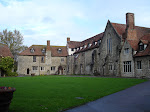
Pilgrims for the Midlands, the North and East Anglia, and those from London, would cross London Bridge to Southwark. Chaucer's pilgrims began their journey at the Tabard Inn at Southwark. Pilgims followed the Roman Watling Street to Canterbury. The distance of some fifty four miles seemed to have taken three to four days. They followed the route that would have been taken by Becket from London to Canterbury on his last journey.
Chaucer mentions Deptford, Greenwich, Rochester and Sittingbourne. The first night would probably have been spent at Dartford. Pilgrims would then ford the River Darent, and continue until they crosed the wooden bridge spanning the Medway into Rochester. Most pilgrims would spend their second night in or near Rochester. Inns included the Crown (the oldest), and later the Bull and the King's Head. Pilgrims probably changed horses at Rochester. A well established system of horse hiring existed. Eight miles beyond Rochester is Newington where st Thomas confirmed some children shortly before his death.
Five miles beyond Sittingbourne, where Henry V refreshed himself at the Red Lion on the way home from Agincourt, and where Chaucer's pilgrims halted, is Ospringe, with it's celebrated Maison Dieu, which gave hospitality to wayfarers. Here Henry II stayed. In the adjacent town of Faversham pilgrims could see a piece of the True Cross at the Cluniac Abbey, which contained the bones of it's founder King Stephen and his wife Matilda.
At Boughton under Blee (now Boughton Street) the Canon's servant joined Chaucer's pilgrims. Then they ascended the hills of the forest of Blean. The road passes through Upper Harbledown, descends to a valley and climbs again to the village described by Chaucer as "Bob-up-and-down" or Harbledown. It was here that Henry II made his gift to the almshouses, and dismounted to walk into Canterbury. From the eastern brow of the hill the pilgrims could see Canterbury and the Cathedral. They would go down the road, crossing the Stour, and into the city through the West Gate, half a mile beyond St Dunstan's Church.


No comments:
Post a Comment